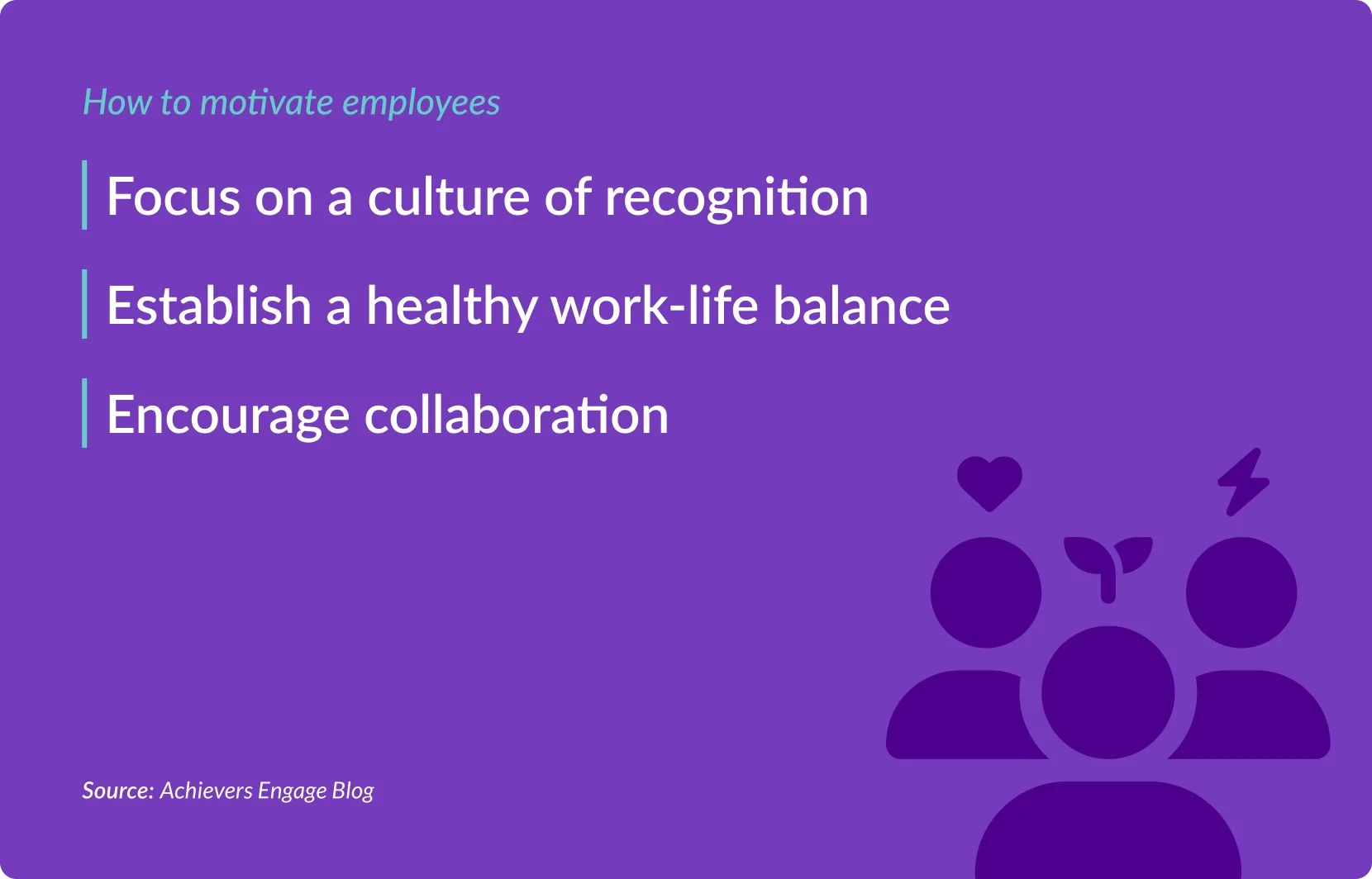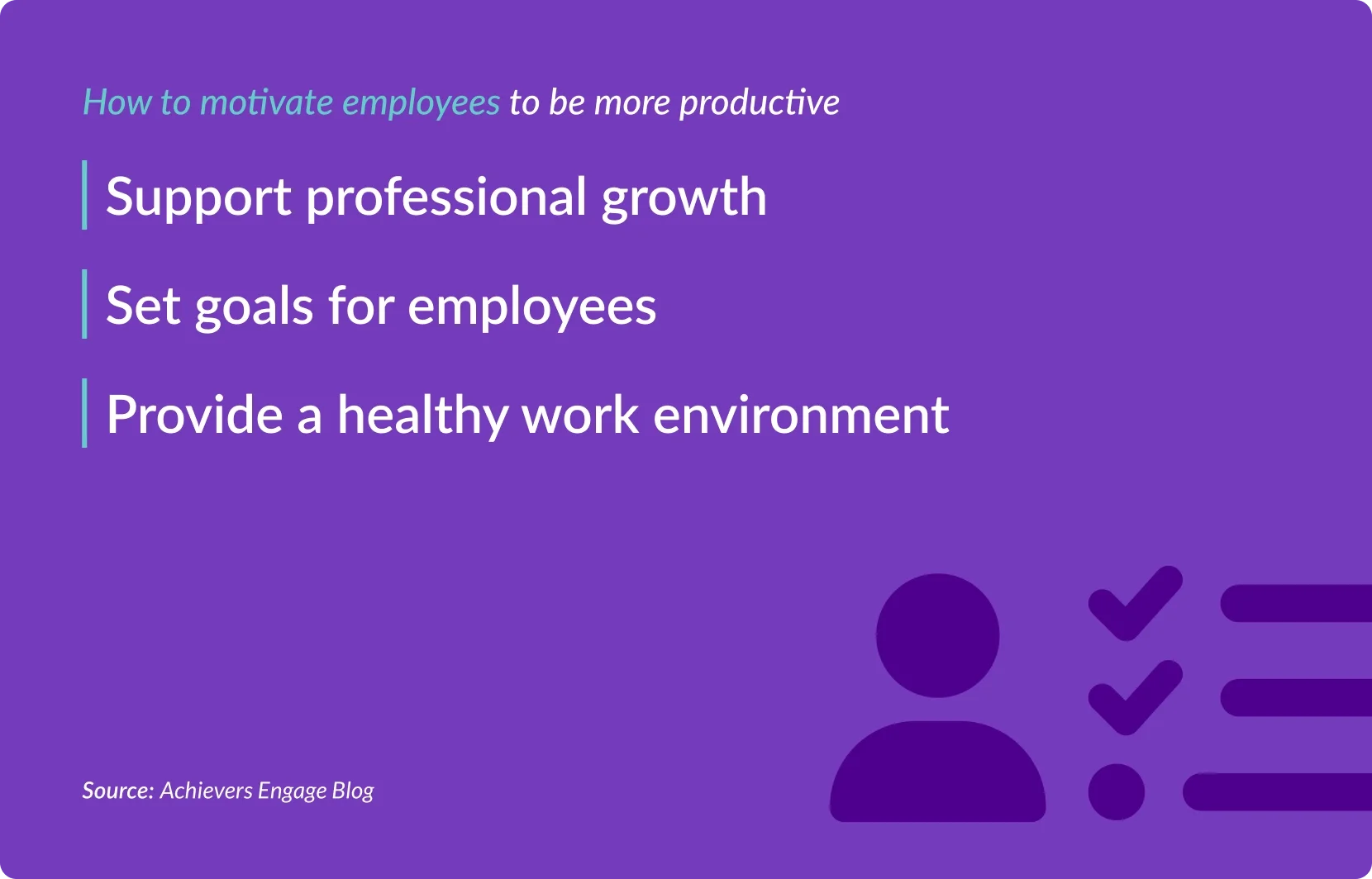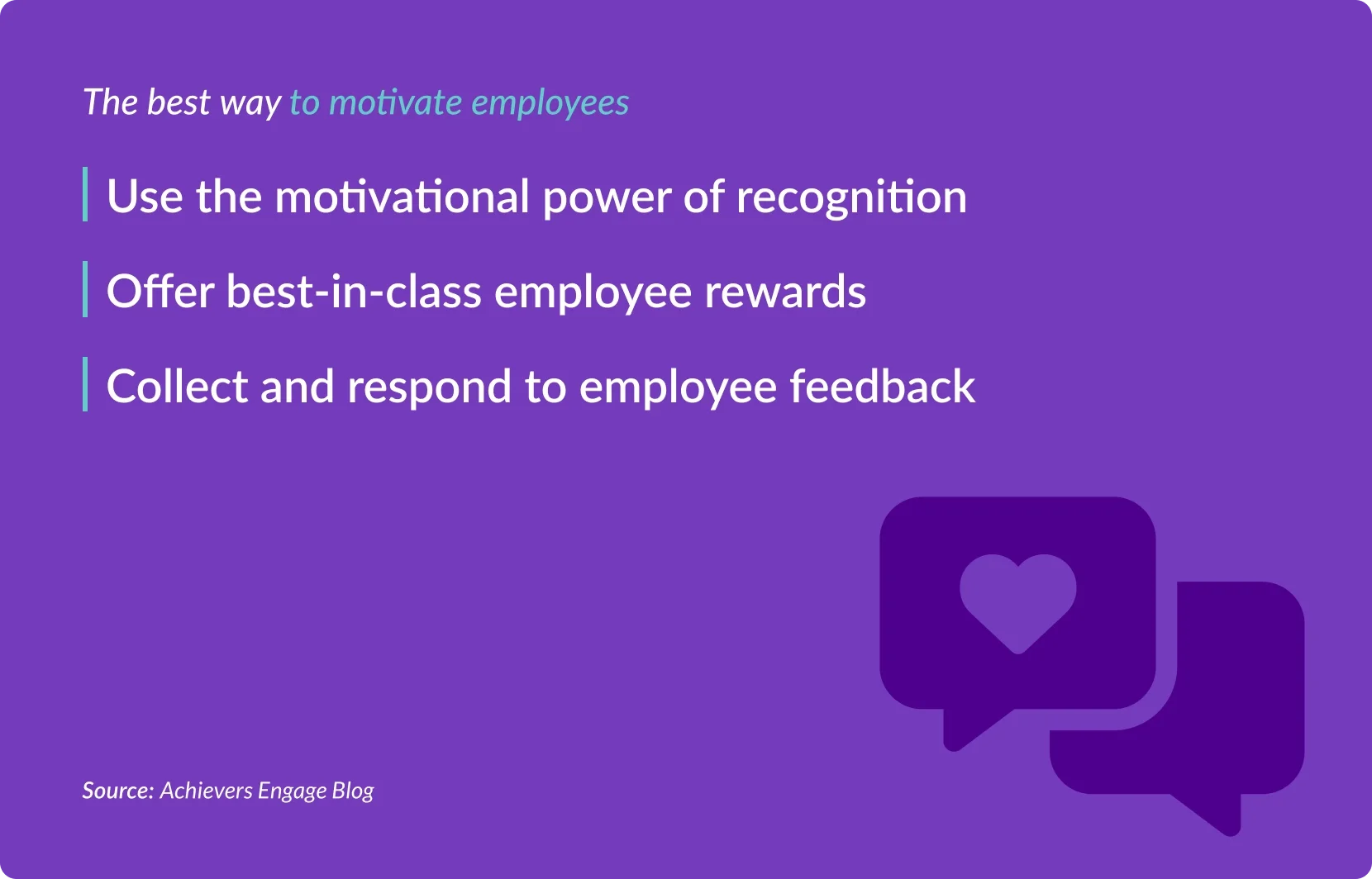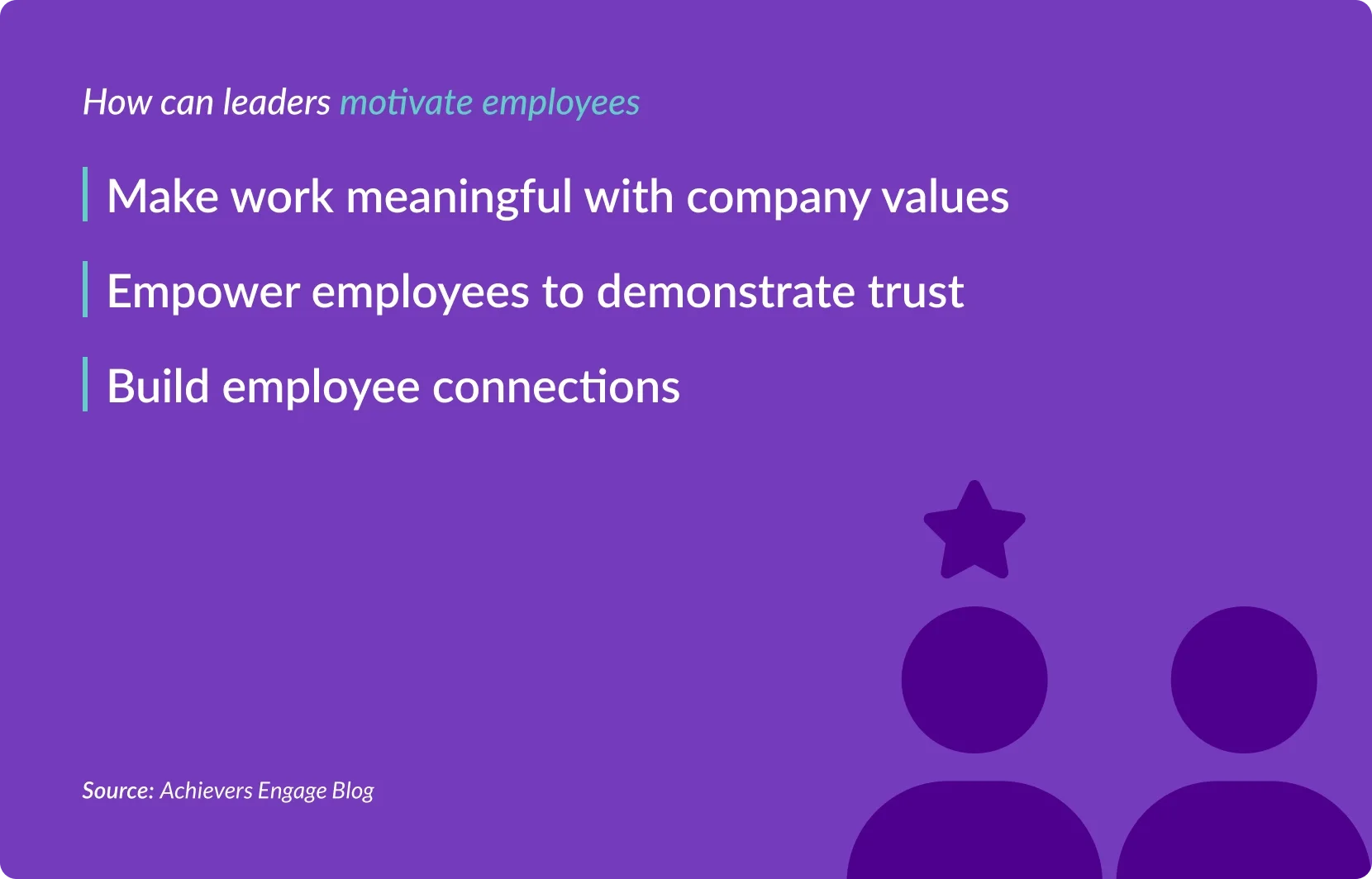Table of contents
Struggling to keep your team motivated? You’re not alone. Employee motivation isn’t just about paychecks or perks — it’s about fostering an environment that inspires and energizes. The good news? There are plenty of simple, yet powerful ways to reignite that spark. Whether it’s through recognizing small wins, offering professional development, or creating a culture of trust and autonomy, the right strategies can turn an unmotivated team into one that’s fully engaged and thriving.
How to motivate unmotivated employees?

When employees lose motivation, it’s crucial to figure out why. Maybe they’re feeling overlooked or stuck in a rut. A quick fix? Start recognizing their efforts — small wins included! Clear communication, professional development opportunities, and flexibility can breathe new life into their work. Empower them with more autonomy, and you’ll see a shift in their attitude and productivity.
How can employees be motivated to be more productive?

Boosting productivity is all about creating the right environment. Set clear goals that align with what your employees care about, offer recognition for hitting milestones, and give them the freedom to own their projects. Plus, who doesn’t love some extra learning opportunities? Training and upskilling can make a world of difference in keeping them engaged and productive.
What are the best ways to motivate your employees?

Motivating employees isn’t rocket science, but it does take consistency. Regular recognition, growth opportunities, and clear communication are key. Make sure employees feel appreciated — whether it’s through a shoutout, a bonus, or offering flexibility. When you combine trust, mentorship, and a supportive culture, you’ll see motivation skyrocket.
How do leaders motivate employees?

Great leaders know motivation starts with them. Leading by example, providing a clear vision, and fostering open communication are all part of the package. Regular feedback, recognition, and career development opportunities go a long way too. When employees feel empowered and valued by their leaders, they’re not just motivated — they’re ready to give their best every day.
21 tips to motivate employees
Ready to see a shift in productivity and morale? Here are 21 tried-and-true ways to motivate your employees and elevate your workplace:
1. Build a culture that motivates employees daily
To sustain long-term employee motivation, create a culture that supports and inspires your team daily. Start by identifying key cultural traits that employees value and get leadership involved — this is crucial, as nearly half of employees feel leadership isn’t committed to improving culture. With only 15% of workers worldwide feeling engaged in their work, active leadership participation in cultural initiatives is essential. When leaders are genuinely involved, employees feel more connected to the company’s mission and values. By maintaining culture continuity, your team will stay motivated.
2. Establish a healthy work-life balance
Overwork leads to anxiety and burnout, major demotivators that undermine productivity. With 31% of workers now valuing a job that respects their work-life balance over salary, it’s clear that digital flexibility — while valuable — can blur the boundaries between work and personal time. Poor work-life balance not only lowers productivity but also drives employees to seek other opportunities. Employers must foster balance by encouraging breaks and time to recharge. Leading companies address this need by offering programs such as child-care assistance, wellness initiatives, and mandatory paid time off. Providing flexibility in the workplace can significantly reduce stress, enhance productivity, and boost motivation.
3. Encourage collaboration
Collaboration has been proven to boost employee motivation and performance. For example, a Stanford study found that collaborative workers not only worked 64% longer but also reported higher engagement, lower fatigue, and better success rates. Teamwork fosters strong relationships, enhances culture, and accelerates goal achievement. It also creates opportunities for bonding, contributing to a supportive work environment. By promoting collaboration at work, organizations achieve better results and build a more engaged, motivated workforce.
4. Provide paths for professional growth
Career advancement is a major motivator for employees. Prioritizing learning and development, and defining clear career paths are crucial for motivation, retention, and ROI. Top companies often credit their success to a focus on internal development. For instance, Fortune 100 “Best Companies to Work For” offer nearly double the training hours compared to others. Managers can support growth by funding classes, offering in-house training, providing actionable feedback, or creating new roles aligned with employees’ strengths. These opportunities not only enhance company performance but also serve as powerful daily motivators for employees.
5. Set goals for employees
Goals are crucial for motivation, offering a clear path and a sense of tangible progress. Employees whose managers involve them in goal setting are 3.6 times more likely to be engaged. However, only 21% of employees strongly agree that their performance metrics are within their control. Long-term goals deliver a significant sense of accomplishment, while short-term goals provide incremental achievements that sustain motivation. To ensure objectives and key results (OKRs) are clear, meaningful, and realistic, track both types of goals and make goal-setting a collaborative process between managers and employees.
6. Empower autonomy
Empowering autonomy in the workplace boosts motivation by allowing employees to make decisions and own their work, which enhances job satisfaction and fosters innovation. An Atlassian study shows that 83% of employees with more choice had a positive view of their organization’s culture, compared to 47% of those without control. When employees have input on goals and tasks, they feel trusted and respected, leading to greater engagement. This culture of autonomy reduces micromanagement, enabling leaders to focus on strategy while employees manage daily operations with confidence.
7. Offer food in the workplace
Providing food in the workplace is a simple yet effective way to boost motivation and satisfaction. Offering nutritious snacks and meals keeps energy levels up and shows that employee well-being is a priority, reducing stress and fostering a positive environment. A shared space for breaks and meals also encourages informal interactions and bonding, enhancing teamwork. In fact, 66% of millennials would consider a job at a company with better perks, like snacks, over their current position. Investing in regular meal options or occasional catered events can significantly improve employee morale and make the workplace more vibrant and attractive.
8. Healthy work environment
A healthy work environment is vital for employee motivation and well-being. With 42% of employees rating their mental health as fair or poor and 32% linking work-related stress to poor sleep, prioritizing physical and mental health support is crucial. Ensuring employees feel valued and secure boosts engagement and productivity. Organizations should provide ergonomic workspaces, wellness programs, and encourage regular breaks. Open communication and transparent leadership address issues swiftly, building trust. By focusing on psychological safety and these elements, you create a positive atmosphere where employees feel motivated and empowered to excel.
9. Take advantage of the motivational power of recognition
A successful recognition strategy combines monetary and social rewards within a strong culture of recognition. Frequent, real-time recognition — rather than just during anniversaries — doubles employee engagement and productivity and makes them 2.5 times more likely to feel a sense of belonging. Be specific and transparent about the behavior being recognized and align it with company values. Implement a points-based reward system, letting employees choose what matters most. Use an employee recognition platform for easy access and leverage data insights to continuously improve the program.
10. Tailor motivation to meet team members’ individual needs
Employee motivation is not one-size-fits-all; personalization is crucial. Different factors, both intrinsic and extrinsic, drive individual motivation, and employees seek meaningful work and new experiences. Managers should motivate employees personally by first asking about their goals and preferred reward types. Some may value development opportunities in their passion areas, while others might prefer new projects that align with their interests, fostering team connections. Choosing a recognition platform with a diverse and evolving catalog ensures that rewards are always tailored to individual preferences.
11. Offer employee rewards
Providing employee rewards effectively boosts motivation and engagement. Achievers Workforce Institute (AWI) research shows that employees with access to a reward marketplace are 61% more likely to feel a strong sense of belonging and 60% more likely to feel meaningfully recognized. Rewards, including bonuses, extra vacation days, gift cards, and public acknowledgment, recognize hard work and reinforce positive behaviors. A well-structured rewards program can foster healthy competition, drive performance, and align with company goals. Personalizing rewards to match employees’ preferences ensures they are impactful, fostering a positive work environment and enhancing organizational culture.
12. Collect and respond to employee feedback
Employees are more motivated when they feel heard. Regular feedback, through pulse surveys or HR chatbots, helps employees express themselves and feel valued. Use these tools to gauge employee sentiment and assess the success of your motivational efforts. However, collecting feedback is only the start; employers must act on it. After analyzing survey results and comparing them to previous data, identify trends and areas for improvement. Review feedback with managers to make informed decisions. When employees see their input influencing business decisions, they feel their voices matter and are more likely to continue providing valuable feedback.
13. Retain your top talent
Retaining employees is crucial for maintaining a competitive edge, especially since 51% of U.S. employees are open to leaving their organization. High performers bring valuable skills and creativity, and their departure can harm productivity and morale. To keep top talent, understand their motivations and provide growth opportunities. Offer regular feedback, recognize their contributions, and ensure they feel valued. Foster a positive, inclusive work environment that promotes collaboration and job satisfaction. Personalized development plans and competitive compensation are also essential. By focusing on these strategies, you can keep your best talent engaged and committed to your company’s long-term success.
14. Focus your leaders on motivation
Employees rely on management to guide the organization, making leadership a key driver of motivation. According to Forbes, the top three in-demand leadership skills are coaching, leading change, and providing feedback. Leaders should prioritize these skills and align their strategies to boost motivation. Recognizing team members through praise or rewards significantly impacts morale, while coaching enhances team dynamics and strengthens motivation. It also helps managers refine observation and communication skills, meeting millennials’ expectations for a more engaging, supportive manager-employee relationship. By mastering these leadership skills, managers can drive both individual and organizational success.
15. Make work meaningful with company values
Company values can be a powerful tool for engaging and motivating employees. When team members are provided with a vision they can relate to and rally around, they work harder. A mission statement that truly reflects the organization’s vision and values is a great start, but you need to follow through on what it promises. Embed the vision and values expressed in the mission statement into the culture of the organization to drive meaningful employee experiences and a more motivated team.
16. Empower employees to demonstrate trust
Trust in leadership is essential, yet only 21% of U.S. employees trust their organization’s leaders. That’s why building trust is a two-way street — managers must also trust their team. Granting autonomy and independence boosts motivation, as employees who have control over their work are more satisfied. Set clear expectations but let employees manage their tasks and challenge them by delegating responsibilities aligned with their strengths. Reward successes and use setbacks as coaching opportunities to develop skills. This approach fosters mutual trust, engagement, and a stronger, more motivated workforce.
17. Practice transparency
Employees want to know everything they can, including how the business is doing, where they fit into the big picture, and what the competition is doing. According to the Deloitte research, 86% of leaders say that increased transparency leads to greater trust. Whether sharing survey results, maintaining an open-door policy, or providing insight into key company decisions, organizations that prioritize transparency build trust and collaboration. By openly sharing strategic business information, companies can foster a culture of trust and maintain control of the conversation, ensuring employees feel informed and valued.
18. Fight boredom by keeping things fresh
Even exciting jobs can become routine, and 46% of U.S. workers report feeling bored at least three days a week, according to Gartner. To combat this, introduce novelty to keep your team motivated. Offering new opportunities, friendly competitions, collaborative games, and regular team building events can boost engagement. Regular check-ins with employees allow you to understand their needs and adjust roles and routines to sustain motivation. This approach keeps work interesting while enhancing wellness and engagement, showing employees that you value their experience.
19. Offer flexible scheduling
Flexible scheduling is a powerful motivator, especially as the world of work continues to evolve. Employees want leaders to understand these changes and recognize that embracing flexibility is key to being a better employer. With 58% of U.S. workers seeking more flexibility, offering options like remote work or adjustable hours reduces stress and enhances job satisfaction. Companies that adapt to these shifting expectations see higher engagement, lower turnover, and increased productivity. By embracing flexibility and empowering employees to balance their personal and professional lives, organizations can foster a more motivated, loyal, and forward-thinking workforce.
20. Share positive feedback
Positive feedback is a game-changer when it comes to boosting motivation and engagement. In fact, employees who receive meaningful feedback are 80% more likely to be fully engaged. It’s simple — when people feel valued, they’re more motivated to perform at their best. Whether it’s a quick shoutout in a meeting, an appreciation card, or a public acknowledgment, positive feedback reinforces good behavior and keeps morale high. Plus, using company platforms to spotlight individual successes helps build a sense of belonging at work. By consistently giving meaningful feedback, you’re creating a vibrant, supportive work environment where everyone’s ready to thrive.
21. Build employee connections
Genuine relationships at work can significantly boost collaboration at work. According to a Gallup report, employees with a close work friend are more likely to engage customers effectively, accomplish tasks faster, support a safer workplace, innovate, and have fun at work. Strengthen camaraderie through regular team-building activities, social events, and collaborative projects, encouraging connections beyond daily tasks. Offer opportunities for mentorship and peer learning to enhance growth and deepen bonds. By fostering open communication and an inclusive culture, organizations can build trust and respect, leading to a more motivated, productive, and satisfied workforce.
Discover how to motivate employees with the right tools
Fostering and sustaining motivation in the workplace is essential for driving long-term engagement and productivity and employers play a crucial role in implementing effective practices and programs. If you want to keep employees engaged and motivated throughout the year, you need the right tools to stay on track.
Achievers provides the robust tools you need to foster a culture of motivation. Achievers Listen enables continuous employee feedback through check-ins and pulse surveys, offering managers and HR valuable insights into what truly matters to their team. This feedback helps make informed decisions to boost satisfaction and engagement. Meanwhile, Achievers Recognize streamlines the recognition process, allowing employees to easily give and receive acknowledgments and redeem points for rewards that resonate with their preferences, enhancing motivation and satisfaction.
By leveraging these tools, organizations can build a dynamic and motivating work environment, ensuring that employees remain engaged, valued, and motivated throughout their journey with the company.



